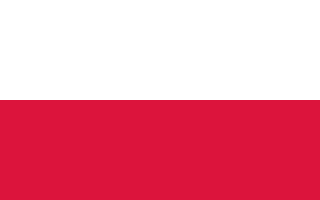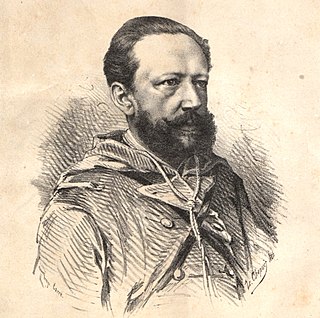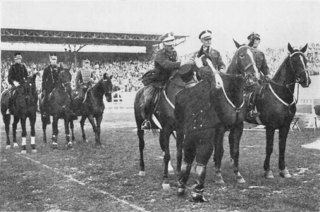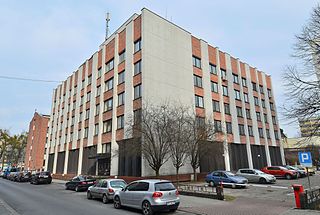
The Polish–Russian War of 1792 was fought between the Polish–Lithuanian Commonwealth on one side, and the Targowica Confederation and the Russian Empire under Catherine the Great on the other.

Aleksander Józef Skrzyński was a Polish politician from Zagórzany, Galicia, who served as the 13th Prime Minister of Poland from 1925 to 1926.

Poland competed at the 1996 Summer Olympics in Atlanta, United States. 165 competitors, 126 men and 39 women, took part in 126 events in 20 sports.

Prince Witold Leon Karol Adam Jarosław Jerzy Czartoryski was a Polish noble (szlachcic) and landowner. He served as the general commissar of Galicia and Lodomeria from the end of Russian occupation in 1917 to full incorporation as part of Poland on 1 November 1918. He was a hereditary member of the Austrian House of Lords (Herrenhaus) from 1908 and an elected Senator of the Polish Republic (1922–28)

Juliusz Fortunat Kossak was a Polish historical painter and master illustrator who specialized in battle scenes, military portraits and horses. He was the progenitor of an artistic family that spanned four generations, father of painter Wojciech Kossak and grandfather of painter Jerzy Kossak.

Count Józef Hauke-Bosak was a Polish general in the January Uprising, and commander of the Polish army in Lesser Poland, the closest collaborator of rebellion leader Romuald Traugutt. He fought many successful battles against the Russians in this region. He fled Poland after the Uprising collapsed in 1864. He died in the post of commander of brigade in the French army at Vosges, during the Franco-Prussian war in 1871.

Piotr Michałowski was a Polish painter of the Romantic period, especially known for his many portraits, and oil studies of horses. Broadly educated, he was also a social activist, legal advocate, city administrator and President of the Kraków Agricultural Society. The Sukiennice Museum, a division of the National Museum in Kraków, contains a room that is named after him and devoted to Michałowski's work.

Piotr Ożarowski was a Polish noble (szlachcic), politic and military commander. Member of the infamous Confederation of Targowica, he reached the offices of Great Crown Hetman and castellan of Wojnice.

The Gallery of 19th-Century Polish Art at Sukiennice, is a division of the National Museum, Kraków, Poland. The gallery is housed on the upper floor of the Renaissance Sukiennice Cloth Hall in the center of the Main Market Square in Old Town Kraków.

Kapists or KPists, also known as the Colourists, were a group of Polish painters of the 1930s who dominated the Polish artistic landscape of the epoch. Contrary to Polish romanticist traditions, the Kapists underlined the independence of art from any historical tradition, symbolism or influences of literature and history. They were formed around Józef Pankiewicz and were under strong influence of the French Post-Impressionists.

Kamil Wiktor Stoch is a Polish ski jumper. He is one of the most successful ski jumpers in the history of the sport, having won two World Cup titles, three Four Hills Tournaments, three individual gold medals at the Winter Olympics, individual and team gold at the Ski Jumping World Championships, and individual silver at the Ski Flying World Championships. His other tournament wins include Raw Air (twice), the Willingen Five, and Planica7.

The Przyszowice massacre was a massacre perpetrated by the Red Army against civilian inhabitants of the Polish village of Przyszowice in Upper Silesia during the period January 26 to January 28, 1945. Sources vary on the number of victims, which range from 54 to over 60 – and possibly as many as 69. The Institute of National Remembrance, a Polish organization that carried out research into these events, has declared that the Przyszowice massacre was a crime against humanity.

Kazimierz Szosland was a Polish horse rider, major of the Polish Army, who competed in the 1924 Summer Olympics and in the 1928 Summer Olympics.

Piotr Józef Cieśla is a former Polish handball player who competed in the 1976 Summer Olympics and won a bronze medal with the Polish team.

The Polish Episcopal Conference or Polish Bishops' Conference is the central organ of the Catholic Church in Poland. It is composed of 3 cardinals, 24 archbishops and 118 bishops.

Józef Zapędzki was a Polish sport shooter.
In Polish poetry, the Ukrainian school were a group of Romantic poets of the early 19th century who hailed from the southeastern fringes of the Polish-inhabited lands of the time. The poets—Antoni Malczewski, Józef Bohdan Zaleski, Tomasz Padura, Aleksander Groza and Seweryn Goszczyński—produced a distinct style of Polish Romanticism through the incorporation of Ukrainian life, landscapes, history, political events, and folklore into their works. They in turn influenced both Lithuanian and Ukrainian Romantic poetry, and, along with other Polish poets, constituted a link between the various literatures of the post-partition Commonwealth.
The Ashes is a 1965 Polish historical drama film directed by Andrzej Wajda, referencing the classic Stefan Żeromski epic novel of Polish Literature of the same name. It was entered into the 1966 Cannes Film Festival. It sold about 6 million tickets in Poland, becoming one of the highest-grossing Polish films of all time.

The 1923 Kraków riot, or 'riots', or 'bloody Kraków events', took place during a demonstration on 6 November 1923 in Kraków, Poland. The incident is also called the 1923 Kraków uprising, particularly by Marxist sources. Demonstrators took control of the Main Market Square area and disarmed some troops. Eventually troops and police were ordered to fire on the workers, but some soldiers refused. Three armored cars were used, one of which, named Dziadek ("Grandpa"), was captured by the workers in the Market Square area.

Colonel Königsfels Teaching Prince Poniatowski to Ride is a 1773 oil painting by Italian artist Bernardo Bellotto that is now in the collection of the National Museum, Warsaw. It depicts Prince Józef Poniatowski, wearing the uniform of the Crown Army's Royal Guards and astride a grey Lipizzan horse, executing a pesade. To the right of Poniatowski is Colonel Piotr Königsfels, holding a staff and displaying the sign for a pesade. In the background, there is an arch bearing the Poniatowski and Ciołek coat of arms.


















